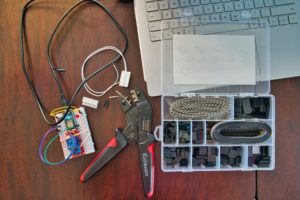Do you know how to fix a water damaged laptop? If you’re like most people, you’ve probably never given much thought to your laptop. Sure, it might come in handy when you need to do some work or watch a movie on the go-but otherwise? You leave it sitting at home plugged in and charging all day long. But what happens if something goes wrong? What would happen if your laptop was damaged by water? It can be devastating! That’s why I’m writing this blog post for everyone who has ever had that question.
Also read: How to Fix Laptop Screen

Image credit: unsplash.com
Tips On How Fix A Water Damaged Laptop
1) First things first-do, don’t panic! Call the experts right away when your laptop gets wet (or even starts flooding). Don’t try to fix it yourself-you could end up doing more damage than good.
There are three professionals you can contact right away, each of whom comes with their own set of skills to help get the job done right:
-Your local computer repair shop
-A data recovery service provider
-Your friendly neighborhood PC technician
2) The next step is to turn off your device ASAP! Then remove the battery and get it to a dry location ASAP. If your laptop is still on, keep the power button pressed until the device turns off completely (or as much as possible).
3) Turn off all peripherals such as external hard drives and USB devices to avoid further damage or data loss.
4) Next, you’ll want to wait for the water to evaporate. This may take 24 hours or more-so, be patient! If you attempt to use the device before most of the water has cleared out, all that’s left behind will mix with corrosive compounds like salt and create mold.
5) When your laptop is dry enough (and not before), it’s time to remove the hard drive. If you have additional questions or concerns about this, reach out to a professional for assistance.

Image credit:unsplash.com
6) When the hard drive has been removed, it’s time to turn your attention to the motherboard-this is where things get serious. The heat from water exposure can cause corrosion and leave your laptop beyond repair. But don’t panic! With professional help and the right knowledge, you can fix this problem and save your laptop.
7) The first step in repairing a water-damaged motherboard is to disassemble the unit completely. Then use cotton balls or swabs to dry out all components thoroughly. You’ll also want to remove any leftover moisture using compressed air.
8) Once everything is as dry as possible, you’ll want to turn your attention to the board components. This might include the cooling fan and heat sink. Be extremely careful here–you don’t want a short circuit caused by residual moisture!
9) With all components dried off, it’s time to reassemble everything. It’s an extremely delicate process, so be extra careful during this time.
10) Reinsert the hard drive back into the device and turn it on to see if everything works properly. You may have some data loss-but in most cases, repairs made by a professional allow you to save everything from your hard drive! With a few tips and tricks, you can save your laptop from water damage when it’s in good hands.
Also read: How to Clean a Laptop Fan

Image credit: unsplash.com
Preventing Water Damage In The Future
- Remove the battery and unplug the laptop immediately if it falls into water, then place it horizontally on a towel or napkin and dry off all openings (USB ports, air vents, etc.). Use a hairdryer to blow out any residual water in crevices and avoid submerging your laptop in rice, as this will damage your motherboard if left in for too long.
- Remove the hard drive (if you are comfortable doing it) or take out the battery and put your laptop in front of a fan so that there is sufficient airflow to evaporate any residual water. If you can hold the keyboard upside down over a sink spray with cold tap water while moving the keys (or blow with air), this will do the trick.
- Once all visible water is gone, wipe down your laptop using a clean rag or paper towel and place it in front of a fan to dry completely – be patient. Avoid placing anything like discs on top until it is fully dry. This process can take more than 24 hours.
- Once your laptop is completely dry, replace the battery, then plug it in and try turning it on. If it doesn’t work, you might have to open up your machine to check the motherboard for any faults, but generally, if you managed to turn it on once, there shouldn’t be anything seriously wrong with it.
Also read: How do you install a wireless mouse on a laptop?
Conclusion
Following these ten simple steps can save your laptop, so make sure you know them inside out before the next time it falls in water or gets exposed to moisture. Remember, don’t panic! When it comes to repairing a laptop that has been exposed to any liquid, knowledge is power, and regardless of how confident you are with laptops, if you take it to a professional, they will know exactly what they’re doing. Your laptop and all of its data can be saved in most cases. Even if you are confident with laptops, there’s no shame in calling upon the help of a professional just for peace of mind! Whatever you do, don’t let this happen again. Even if you have a water-resistance laptop, it is never a good idea to expose any device moving parts to liquid.

Image credit: unsplash.com
Frequently Asked Questions
Can a Laptop With Water Damage Be Repaired?
When you get water damage on your laptop, it does not necessarily mean the end of life of the computer. Modern technology has made it possible for computers to function even after falling in water or taking other kinds of damage. If your laptop is still functioning correctly after falling in water, there’s a chance that it can be repaired.
Will Water Damage a Laptop Permanently?
Yes, water damage can permanently break a laptop. Water damage is serious and needs to be repaired as soon as possible. Suppose you spilled some juice on your keyboard. In that case, you should try quickly turning it off, taking the battery out if the case of laptops that have one, getting rid of any USB devices or anything else connected to it – basically pull out anything that’s not built-in. You can now take it apart to let it dry out.

One comment
Comments are closed.